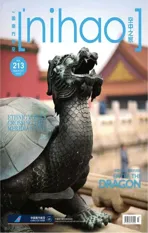Mythical Creatures in Dunhuang Murals
2017-04-10JiangLan,Leo,JiangLan
Mythical Creatures in Dunhuang Murals
敦煌壁画里的“畏兽”
Text by Jiang Lan Translation by Leo Photos provided by Jiang Lan


A Portrait of a Creature with Nine Human Heads created in Eastern Han Dynasty (25-220 AD) and unearthed in Huang'an Ling Village, Tengzhou City, Shandong province《九头人面兽画像》东汉,山东滕州黄安岭出土
北魏晚期的洞窟壁画中,出现了道风浓郁的神话题材。敦煌249窟顶部,除了莲花藻井,东西两面画阿修罗与摩尼珠,南北两面画东王公、西王母驾龙车、凤车出行。车上重盖层叠,车后旗袂飘飘,前有持节扬幡的方士开路,后有人首龙身的开明神兽随行。朱雀、玄武、青龙、白虎分布各壁。其中最为神奇的,当属开明兽。

A picture of Xiangliu, the nine-headed snake from an illustrated book by Ming book publisher Hu Wenhuang相柳 【明】胡文焕 图本
The theme of mythology featured strongly in murals that were found in some Dunhuang caves and were created in the Northern Wei Dynasty (386–534). For example, the ceiling of Mogao Cave No. 249, in addition to a caisson in the shape of a lotus flower, featured paintings of asuras and Mani beads (a wish-fulfi lling jewellery and a metaphor for the Buddha's wisdom) on east and west sides as well as paintings of the Eastern King and the Western Mother Queen (two key Taoist immortals), riding in a dragon-drawn vehicle and a phoenix-drawn vehicle, on north and south sides, respectively. Both the vehicles, decorated with splendid canopies on top and fluttering flags at the back, were led by Taoists who held fl ags and were followed by godly creatures, which each have a dragon's body and multiple human heads. The four walls of the cave featured the four legendary animals in ancient China– Scarlet Bird, Snake-turtle, Blue Dragon and White Tiger. The most magical of all these creatures and animals are the multiple-headed ones, known as“Kai-ming”.


An up-close view of the Kai-ming as part of the Hunting Scene in Cave No. 249敦煌249窟《狩猎图》中的开明兽(局部)
The term “Kai-ming” (literally meaning “being enlightened”) first appeared in Shan Hai Jing, a Chinese classic text and a compilation of early geography and myth, which cites Kai-ming as the guardian of Kunlun Mountains. The paintings of the creature carved on stones (or bricks) that were unearthed in Sichuan province, Tengzhou in Shandong province and Xuzhou in Jiangsu province and those that appeared in embroidery work depicting stories from Shan Hai Jing throughout history showed that this creature has nine human heads as opposed to the thirteenheaded ones seen in the Cave No. 249. The arrangement of the heads of the latter is also one of a kind.
Sketches were already available to guide the work of mural painters at the time, but the sketch of Kaiming was still too rare to come by, I guess. This gap created an opportunity where the imagination and creativity of the mural painters was allowed full play. Just like the evil-dispelling creatures that guard the gates of Heaven, the Kai-ming creatures seen in the murals show no sign of being ferocious and scary, as are those found in Sichuan province and elsewhere in China. Each creature has thirteen heads, all facing sideways, giving the impression of Cubism, and un-carved eyeballs that seem to be staring into your soul. They simply look like a montage of images. The power of the creatures is revealed through rigid ink lines, which may appear simple, but indeed refl ect the painter's unique approach to life. The strokes are rhythmic and powerful and the majestic creatures appear to be jumping out of the wall.
But where did the name of Kai-ming come from? Is it in any way related to the Kaiming tribe or dynasty in the ancient kingdom of Shu (in what is now Sichuan province)? I doubt it. I believe that the name (and the creature itself) originated in ancient mythology from North China.
The tribe and dynasty of Kaiming existed across Minshan Mountain and Jiudingshan Mountain in today's Sichuan province in the Xia Dynasty (21 BC– 16 BC). Though Ba-Shu symbols (hieroglyphs) were widely used by the people of the tribe, no trace of any nine-headed creature has been identifi ed so far in pictures or symbols that were believed to be used as coats of arms or emblems of the tribe. This indicates that no relationship may exist between the name of the creature and the Kaiming tribe. But the acceptance of the creature by the tribe as one of its gods at least shows the tribe's willingness to embrace the culture from China's Central Plains and marks interactions between Ba-Shu Culture and Central Plains Culture.

Jiang Lanauthor of A Philosophical Look at Creatures, A Metaphysical Look at Creatures, and Mythological Creatures in the Palace Museum, etc.蒋蓝著有《哲学兽》《故宫神兽》《玄学兽》等。
